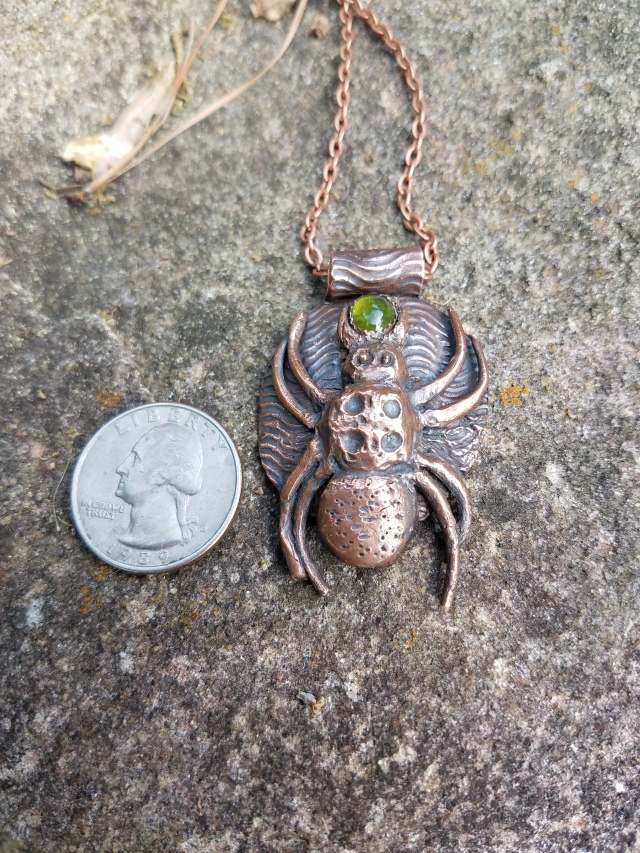Water Spider is a key figure in the mythology of the Cherokee Nation. In some versions of the myth, Water Spider separates dry land from water by bringing up bits of mud from the bottom of the primordial lake. In others, Water Spider introduces humans to fire. While there is quite a bit of variation in the iconography, Cherokee images of Water Spider almost always have certain traits: three distinct body parts; two staring eyes; a cross or cross-like symbol on the thorax; and large, rounded abdomen. That sounds like a good inspiration for the modern jeweler!

I started with a tap light dome, so the piece would not be flat or too rounded. Using Art Clay copper clay, I embossed (used a template with a piece of plastic wrap over the clay, then pushed the template down so the clay emerged in a rounded way) three body parts. I made impressions for a place that the eyes would go later, using the handle of a clay shaper. I used the clay shaper to create a cross-like design on the thorax (although I modified it later). I used a needle tool to put a texture on the abdomen. I hand rolled eight legs. In the picture above, all the parts in their approximate position, although nothing is finalized.
I attached the legs to the thorax. This involved some fiddling, until I found a position that suggested swimming. I made mandibles. I put a copper bezel cup in between the mandibles, so I could later put a stone there. I made two tiny spheres of copper clay, and placed them in the eye depressions, so the spider would have eyes that resembled Cherokee iconography.
Then I made a background, using a texture sheet (the pattern in the texture sheet suggested waves to me), and gave it a bail.

I adjusted the cross-like design, making it deeper and adding some texture around it by dragging copper slip about its edges. After some finishing, the spider was ready to fire.
A piece with this much variability in thickness is harder to fire than most copper clay pieces. Although some people open shelf fire copper, I prefer firing in charcoal — that is what I did here. To make sure it heated all the way through, I ramped up at 900 degrees F per hour to 1800 degrees F. Then I fired the piece for an hour and 20 minutes at 1800 degrees F.
After firing, the piece was brushed, tumbled, and patinaed. I filled the bezel cup with a vesuvianite cabochon. That reflects both versions of the mythology — the green mirrors the earth and, since vesuvianite is a volcanic stone, it matches the fire. Then I was done, lacking only a chain for finishing.

The coin is for scale.
One final word: I’m not Native American. When I started this piece, I worried if I was inappropriately using someone else’s culture. I decided that I was not. First of all, Water Spider is a mythical figure, not a sacred image. Secondly, the Eastern Band of Cherokee operate a museum of tribal history, and they sell images of Water Spider in the museum gift shop. I decided that, as long as I made it clear that this work was not done by a Native artisan, I was not guilty of cultural appropriation.
How does this apply to the metal clay artist? Much of my work has a mythological or historical inspiration. As long as it does not trivialize any living person’s culture, I feel that using such inspiration pays tribute to the sources. I hope you will take the same vie of your metal clay work, and seek inspiration in mythic sources.

